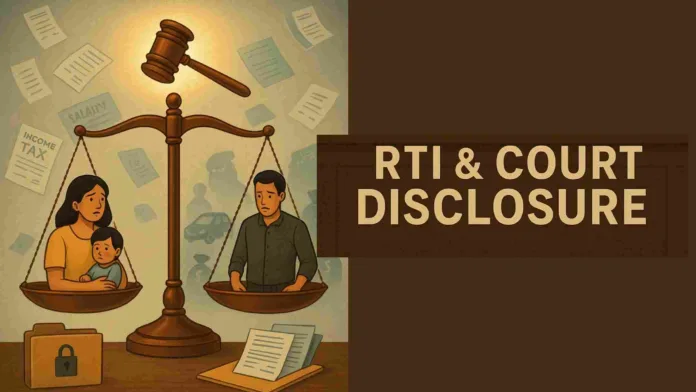When maintenance is disputed in a divorce, a common question follows: If I know my husband’s PAN, can I use India’s Right to Information Act (RTI) to uncover his income and assets? The short answer: not through RTI alone—but there are lawful ways to compel disclosure through the courts, and a few public records tied to a PAN that you can check.
The law draws a hard privacy line
India’s Supreme Court has repeatedly treated income-tax records as “personal information” exempt from disclosure under Section 8(1)(j) of the RTI Act. In Girish Ramchandra Deshpande v. CIC, the Court held that third-party service and tax details cannot be disclosed absent an overriding larger public interest. That position was later reinforced in CPIO, Supreme Court of India v. Subhash Chandra Agarwal, which clarified how “personal information” is balanced against public interest under RTI.
There’s also a second wall: Section 138 of the Income-tax Act, 1961, which restricts disclosure of taxpayer information and sets a special procedure (via senior tax authorities) for any release in public interest. High courts have used Section 138 to reject RTI bids for third-party tax details—stating that assessee information cannot be granted under RTI except through Section 138’s route.
Bottom line on RTI: With just a PAN, you generally cannot obtain someone else’s ITRs, Form 26AS/AIS, TDS history, bank links, or asset details via RTI. Unless a truly compelling public-interest case is established (rare in private matrimonial disputes), information stays confidential.
What you can see that’s tied to a PAN (no RTI needed)
- Income-tax “Know Your AO / Verify PAN”: The e-filing portal offers a public tool that confirms whether a PAN is valid/active and shows the Assessing Officer’s jurisdiction. It uses an OTP (to your mobile) and does not reveal the holder’s income.
- GST registrations mapped to a PAN: The GST portal’s Search by PAN function lists all GSTINs issued on that PAN—showing legal/trade name, registration dates, status, principal place of business, and basic return-filing info (more details appear post-login). This is expressly provided by GSTN as a misuse-prevention feature.
These public lookups can verify whether a person runs registered businesses and where they’re registered—useful leads for maintenance proceedings—but they won’t disclose incomes or bank balances.
What RTI might still give you (narrowly)
RTI can sometimes fetch procedural status—for example, whether a Tax Evasion Petition (TEP) you filed has been received/processed/closed. The Central Information Commission has allowed such generic status disclosures while withholding personal tax data. Recent reporting shows the CIC continuing to protect third-party tax details; courts have backed that approach.
In exceptional circumstances, information necessary to secure maintenance has been released—e.g., a 2012 CIC decision directed disclosure of a defaulter-husband’s GPF accumulation to his wife after prolonged non-payment. Treat this as a narrow, fact-specific exception, not the rule.
The effective route: Court-mandated financial disclosure
For child/wife maintenance, the decisive tool isn’t RTI—it’s the Supreme Court’s 2020 ruling in Rajnesh v. Neha. The Court made standardized Affidavits of Disclosure of Assets & Liabilities mandatory for both parties in maintenance cases (including pending ones). Family Courts can require ITRs, salary slips, bank statements, and business details, and draw adverse inferences if a party conceals income. High courts have been asked to re-circulate these directions to ensure compliance.
Translation for your case: Ask your lawyer to seek immediate directions under Rajnesh v. Neha for full financial disclosure and interim/child maintenance. Courts can also enforce orders through attachment of salary/bank accounts if there’s continued default.
Quick guide: If you have the PAN
- Check public footprints
- Verify PAN status / AO jurisdiction on the IT portal.
- Use GST Search by PAN to list any GSTINs and basic profile/filing history.
- File in court for disclosure
- Move the Family Court (or the court where your maintenance claim is pending) to enforce the Rajnesh v. Neha affidavit and call for ITRs, salary, and bank records.
- (Optional) File a TEP + RTI for status
- If you suspect concealed income, lodge a TEP with the Income-tax Department, then use RTI to seek status of action taken—not his returns.
The takeaway
Knowing a spouse’s PAN does not open their tax records under RTI. Privacy exemptions under RTI and the Income-tax Act’s Section 138 close that door. The workable door is the Family Court, which can compel comprehensive financial disclosure under Rajnesh v. Neha—the most effective path to securing fair child maintenance.
Note: This article provides general legal information, not a substitute for personalized legal advice. For immediate relief, speak with your lawyer about seeking interim child maintenance and a disclosure order at once under the Supreme Court guidelines.
Read More: Death Penalty Cases Can Be Reopened Under Article 32 Petitions: Supreme Court

